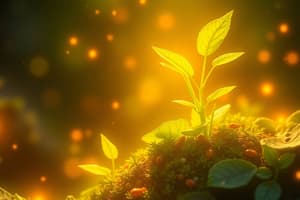Podcast
Questions and Answers
What is the main function of chlorophyll in photosynthesis?
What is the main function of chlorophyll in photosynthesis?
- Generating electron flow to produce ATP and NADPH
- Absorbing sunlight and transferring its energy into chemical energy (correct)
- Storing carbon dioxide overnight for photosynthesis
- Breaking down glucose into sugars and starch
Which pigment is responsible for giving plants their characteristic green color?
Which pigment is responsible for giving plants their characteristic green color?
- Carotenoids
- Photosystem II
- Chlorophyll (correct)
- Xanthophylls
What is the role of carotenoids and xanthophylls in photosynthesis?
What is the role of carotenoids and xanthophylls in photosynthesis?
- Absorbing sunlight for energy transfer
- Concentrating carbon dioxide for fixation
- Protecting chlorophyll from damage (correct)
- Generating ATP and NADPH
In which part of the chloroplast do the light-independent reactions (Calvin cycle) occur?
In which part of the chloroplast do the light-independent reactions (Calvin cycle) occur?
Which pathway do C4 plants, like corn, use to improve their ability to capture carbon dioxide?
Which pathway do C4 plants, like corn, use to improve their ability to capture carbon dioxide?
What is the function of the chlorophyll-protein complex during the light-dependent reactions?
What is the function of the chlorophyll-protein complex during the light-dependent reactions?
What is the main function of chlorophyll in photosynthesis?
What is the main function of chlorophyll in photosynthesis?
Which part of the solar spectrum does chlorophyll a primarily absorb?
Which part of the solar spectrum does chlorophyll a primarily absorb?
What is the role of chlorophyll b in photosynthesis?
What is the role of chlorophyll b in photosynthesis?
Where is chlorophyll primarily found within plant cells?
Where is chlorophyll primarily found within plant cells?
Which type of organic compound is chlorophyll classified as?
Which type of organic compound is chlorophyll classified as?
What is the function of chlorophyll a and chlorophyll b working together in photosynthesis?
What is the function of chlorophyll a and chlorophyll b working together in photosynthesis?
Flashcards are hidden until you start studying
Study Notes
Photosynthesis: The Green Process of Life
Photosynthesis is a fundamental process that powers the planet, transforming sunlight into chemical energy that supports life on Earth. This remarkable phenomenon occurs in plants, algae, and some bacteria, and it's the primary source of oxygen in our atmosphere. One of the key players in this process is chlorophyll, a green pigment that captures solar energy and enables plants to carry out photosynthesis.
Chlorophyll: The Green Light-Harvesting Molecule
Chlorophyll is a phytochemical, a group of organic compounds that are essential for photosynthesis. It's found in chloroplasts, specialized structures within plant cells that are responsible for photosynthesis. Chlorophyll exists in various forms, but the most common are chlorophyll a and chlorophyll b.
Chlorophyll a absorbs blue and red light, which comprises the majority of the solar spectrum. Chlorophyll b absorbs less light, mainly in the blue wavelengths, and it functions to extend the absorption range of chlorophyll a. This complementary action ensures that both pigments capture as much light as possible to drive the photosynthetic process.
The Light-Dependent Reactions
Photosynthesis involves two stages: the light-dependent reactions and the light-independent reactions (also known as the Calvin cycle). The light-dependent reactions occur in chloroplasts and use the energy of sunlight to produce ATP and NADPH.
During the light-dependent reactions, light energy is absorbed by chlorophyll, which gets excited and transfers its energy to an electron carrier called a chlorophyll-protein complex (specifically, the photosystem I and photosystem II complexes). This energy transfer generates electron flow, driving the production of ATP and NADPH.
The Light-Independent Reactions
The light-independent reactions, or the Calvin cycle, occur in the stroma of chloroplasts, resulting in the fixation of atmospheric carbon dioxide into organic compounds like glucose (sugars) and starch. The ATP and NADPH produced in the light-dependent reactions provide the energy and reducing power needed to drive the Calvin cycle.
Photosynthesis Variations
While the majority of photosynthesis occurs through the C3 pathway, some plants employ C4 and CAM pathways to improve their ability to capture carbon dioxide. C4 plants, like corn, use an additional step in their photosynthesis to concentrate carbon dioxide around the enzyme responsible for fixation, increasing its efficiency. CAM plants, such as cacti, store carbon dioxide overnight and release it during the day for photosynthesis, allowing them to be more efficient in dry conditions.
The Role of Chlorophyll in Photosynthesis
Chlorophyll is pivotal in the photosynthetic process, as it absorbs sunlight and transfers its energy into chemical energy. This green pigment is what gives plants their characteristic color. Without chlorophyll and photosynthesis, life as we know it would not exist on Earth.
While chlorophyll plays a central role in photosynthesis, plants are also equipped with other pigments, such as carotenoids and xanthophylls, which protect chlorophyll from damage and light-harvesting pigments that extend photosynthesis into the blue and red parts of the spectrum, ensuring that plants capture as much light as possible.
Studying That Suits You
Use AI to generate personalized quizzes and flashcards to suit your learning preferences.




